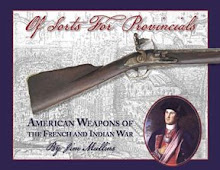A 1763 shipment to Charleston, South Carolina for twelve fowling pieces of varied quality and price from the Wilson firm can be found in the Robert Hogg Account Books. Hogg was a merchant in Charleston, S.C. and Wilmington, N.C.
Vol 1. p31, Robert Hogg Account Books, #343, Southern Historical Collection, Wilson Special Collections Library, University of North Carolina at Chapel Hill.
Crate
93 Case of Richd & Wm Wilson & Compy 12 Octb
No. 1 2 fine Fowling Pieces 18/- 1/16
2. 2 Ditto 25/- 2/10
3. 2 ditto with wrot [wrought/engraved] brass furniture 30/- 3/-
4. 2 ditto Blue Barl. Silver Sights 40/ 4/
5. 2 ditto Barrels to take out & ca. 50/ 5/
6. 2 ditto Ditto & ca. 55/ 5/10
p32
No. 4 Invoice for the Nancy Capt Mitchell Continued
Amount Brought forward....88/1/5
93 a Case of Richd & Wm Wilson Brot forward 21/16
12 list Cases 6
12 Bridle Gun Locks 5/6 3/6/-
12 Setts Screw Pins 2
George Washington's high end "Fowling Piece or Duck gun" by Richard Wilson. Ca. 1750. Yale: de Lancey Kountze Collection, Gift of de Lancey Kountze, B.A. 1899
In addition to fowling pieces, a few entries in the same ledger contain items related to militia and sporting goods that were being imported.
Dead Game (before 1794) Carrington and Bowles. Note the "hair Shot Bags with Button" and "brass mounted Powder flask with Strings".
[p24 on the Little Carpenter for Hogg and Clayton]
#56 Trunk of Whitbread & Gifford 6 Sepbr. 1762
No. 1 6 Buckhandled Lacqd Cuttoes with Belts [cuttoe swords] 4/4- 1/6
2 6 Boiled white Ebony handles with Do 7/6-2/5
3 1 dz Cartouch Boxes 19/-
4 1 1/2 dz hair Shot Bags with Buttons 15/- 1/2/6
5 1/2 dz Ditto ...Ketches 18/ 9/-
6 1 dz brass mounted Powder flasks with Strings 15/-
7 1/2 dz ditto better 39/- 19/6
8 4 ditto without strings 2/6 10/-
9 3 neat Leather Shott Bags with brass Tops 2/6 7/6
10 2 Leather powder flask with strings 3/6 2/
11 1 dx Single Gun Worms Say Hammers 4/
12 1 dx double Do do 8/
13 3 M fine Yellow Gunflints 24/ 3/2
14 1/2 M pistol do 12/-













_and_John_Lawson_(1674-1711)_as_prisoners_of_the_Tuscarora,_1711.jpg)
